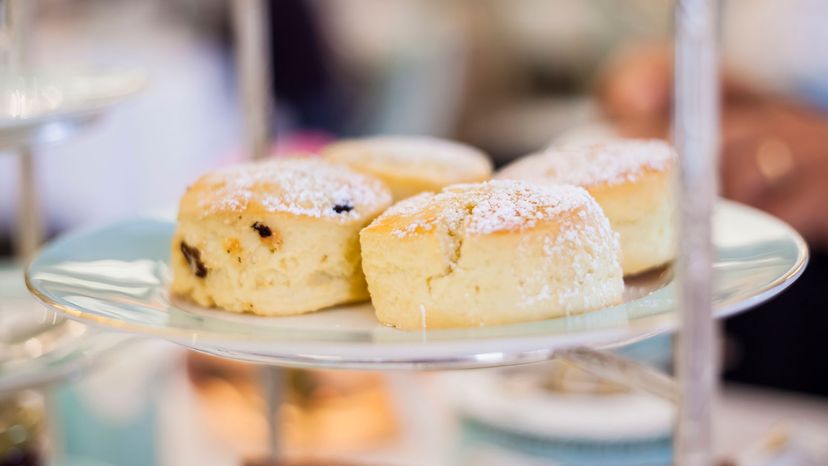
American fans of "The Great British Baking Show" (originally "The Great British Bake Off" in the United Kingdom) and readers of British baking cookbooks quickly learn that Americans and Brits have very different definitions of common baking terms. For example, if an American followed a British biscuit recipe expecting something buttery and flaky for an egg-and-bacon sandwich, she'd be in for a disappointing breakfast.
To clear up the confusion, we asked some experts to fill those in the U.S. in on the biggest differences between British and American baking terms and ingredients, so they won't end up wandering the aisles of an American supermarket fruitlessly searching for black treacle (that's molasses in the U.S.) or a sandwich tin (U.K. term for a layer cake pan).
Advertisem*nt
Contents
- A Biscuit (U.K.) is a Cookie (U.S.)
- A Biscuit (U.S.) Is a Scone (U.K.)
- An English Muffin (U.S.) is a Muffin (U.K.)
- Pudding (U.K.) is Not Pudding (U.S.)
A Biscuit (U.K.) is a Cookie (U.S.)
Well, sort of.
Tim Brown is department chair of the International Baking and Pastry Institute at Johnson & Wales University in Providence, Rhode Island. Born and raised in South Africa, Brown worked as a pastry chef in the U.K. before moving to the States. Brown says his American culinary students think of cookies as these moist, chunky treats stuffed with chocolate chips and other rich delights.
Advertisem*nt
British biscuits, on the other hand, are much plainer, thinner and dryer, he explains. Some are sandwiched around a layer of cream like an Oreo, and others are jazzed up with a coating of chocolate. But none are anything close to moist and chewy.
"I don't think Americans can get their heads around how dry and brittle a biscuit is," says Brown, explaining that biscuits, like Italian biscotti — both derived from the Latin for "twice-baked" — are meant to be dipped in tea or coffee.
Then there are digestives, a subset of British biscuit that's traditionally round, hard and plain, but can now be found covered in all sorts of tempting flavors.

"There is no American equivalent to a digestive," says Lee Faber, an American-born writer and cookbook editor who has lived in the U.K. since 1981. Faber has Americanized or Anglicized more than 200 cookbooks and says that when a British pie recipe calls for pulverized digestives in the crust, she substitutes graham crackers for the American version. And no, there are no graham crackers in the U.K.
Advertisem*nt
A Biscuit (U.S.) Is a Scone (U.K.)
A British biscuit is not remotely similar to the fluffy and filling American biscuits made famous in Southern American cuisine. The closest British equivalent to those buttery miracles is a scone, which ain't too bad either. Both baked goodies use flour, fat, liquid and a leavening agent. The main differences are that scones tend to have less butter (because you'll add butter to it when you eating it — or else, clotted cream or jam) while American biscuits tend to have more butter and light layers. Biscuits are generally served as part of a main meal (for instance, the dish chicken and biscuits), while scones are served at teatime and can be savory or sweet, depending on what is added to them. The American scone is usually a triangular-shaped cookie-like baked good, full of butter, very sweet and loaded with blueberries, chocolate chips or other add-ins.
Advertisem*nt
An English Muffin (U.S.) is a Muffin (U.K.)
Nineteenth-century baker Samuel Bath Thomas may have popularized his English muffins in the United States, but he did not invent them. Over in the U.K., English muffins are simply called muffins and have been around for centuries. In fact, they're the fresh-baked goodies that inspired the traditional British nursery rhyme "Do You Know The Muffin Man?" (hint: he lives on Drury Lane).
In America, they associate muffins with those cakey, cupcake-shaped blueberry muffins or poppy seed muffins. In the U.K., those are sometimes called American muffins. Ask for an English muffin in the Liverpool, though, and you might get some funny looks.
Advertisem*nt
Then there's the crumpet. A crumpet is both similar to what Americans call an English muffin and completely different. At first glance, the two look alike, and both can be toasted and slathered with butter and jam. But Brown says that crumpet dough is more like a thick pancake batter and the resulting baked good is more rubbery than an English muffin, but in a good way.
Also, crumpets are traditionally cooked on a griddle on only one side, so their air bubbles show up on top, whereas muffins are cooked on both side and the air bubbles (aka "nooks and crannies") are trapped in the middle.
Advertisem*nt
Pudding (U.K.) is Not Pudding (U.S.)
Thanks to the dominance of Jell-O pudding in the United States, most Americans have a singular definition of pudding, namely a custard-like instant treat enjoyed alone as a dessert.
Pudding in the U.K. is a lot more complicated. Technically, British pudding includes an array of dishes, both sweet and savory, that are traditionally boiled or steamed. That list includes truly questionable delicacies like black pudding (blood sausage), white pudding (basically blood sausage without the blood) and, yes, haggis. Yorkshire pudding, on the other hand, is like an eggy popover.
Advertisem*nt
On the sweet side, says Faber, the word pudding is commonly used as shorthand for dessert, as in, "What would you like for pudding?" even if the pudding in question isn't "pudding" at all.
Brown says that the closest thing in the U.K. to American-style pudding is custard, which isn't traditionally eaten by itself, but layered into dishes like trifle or enjoyed with some simple stewed fruit.
Now That's Handy
Lee Faber gave us a few extra tips for translating a recipe from English (U.S.) to English (U.K.):Baking pans (U.S.) are called tins (U.K.) as in muffin tins and cake tins, even if the “tin” is made of glass. Golden raisins (U.S.) are the far more poetic-sounding sultanas (U.K.). Shortening (U.S.) is the far less poetic-sounding solid vegetable fat (U.K.).
Advertisem*nt